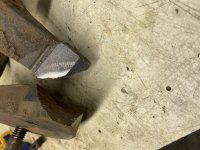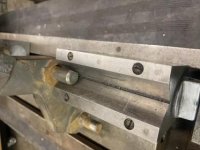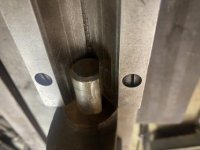wordsmith07
Aluminum
- Joined
- Aug 11, 2018
- Location
- Athens AL
Tried to find a trunnion on the parts for sale/wanted forum but no response.
In searching this site for repairs there were a couple but they were broken in a slotted arc which in my opinion were less stressful places.
The curved surfaces on arms (to me) don't seem to offer a great place to clamp up for drilling.
My intentions are to bore, thread and countersink one or two cap head screws to hold together and braze around the break.
Tell me if the following is a good idea or not please or advise me how to proceed,
1. Thought I might use high temp JB Weld to hold parts together for drilling procedure. I plan to drill tap size to full CHS depth.
2. Drill clearance hole through top piece.
3.Drill counterbore for head.
4. Grind Vee all around cracks.
5. Silver Braze joints.
High Temp supposedly is good for 1000 or 1300 degrees F depending on product used. One is stated as being "paste" and might create a less than desirable spacing between parts. Would the brazing exceed this temp inside part and vaporize the epoxy and contaminate the brazing?
I can use soft pad clamps to hold until epoxy sets then try and bolt entire assembly to a simple fixture for boring/drilling.
I thought about trying a "U" shaped fixture to hold/align the opposing pins pointing outward but these have flats ground maybe one third into them. V blocks wont help here I think.



In searching this site for repairs there were a couple but they were broken in a slotted arc which in my opinion were less stressful places.
The curved surfaces on arms (to me) don't seem to offer a great place to clamp up for drilling.
My intentions are to bore, thread and countersink one or two cap head screws to hold together and braze around the break.
Tell me if the following is a good idea or not please or advise me how to proceed,
1. Thought I might use high temp JB Weld to hold parts together for drilling procedure. I plan to drill tap size to full CHS depth.
2. Drill clearance hole through top piece.
3.Drill counterbore for head.
4. Grind Vee all around cracks.
5. Silver Braze joints.
High Temp supposedly is good for 1000 or 1300 degrees F depending on product used. One is stated as being "paste" and might create a less than desirable spacing between parts. Would the brazing exceed this temp inside part and vaporize the epoxy and contaminate the brazing?
I can use soft pad clamps to hold until epoxy sets then try and bolt entire assembly to a simple fixture for boring/drilling.
I thought about trying a "U" shaped fixture to hold/align the opposing pins pointing outward but these have flats ground maybe one third into them. V blocks wont help here I think.








